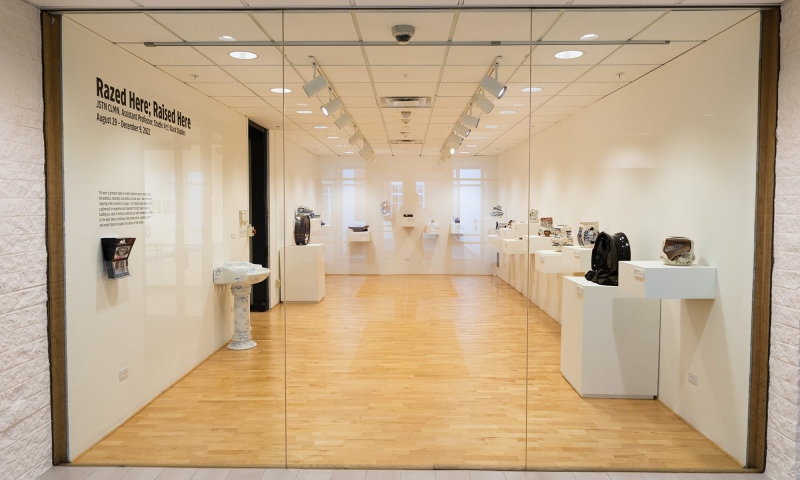Justin Coleman, also known as Jstn Clmn, is an artist and a Denison University professor of studio art and Black Studies who has an eclectic style that offers critique and commentary on both current events and historical issues.
The Newark resident will discuss these themes during a talk about his work from 11:30 a.m. to 1 p.m on Nov. 10 at the Denison Museum in the university’s Michael D. Eisner Center for the Performing Arts. The event is free and open to the public.
Coleman’s mostly white and blue ceramics include found objects, such as car wheels and broken shards from a brown, ceramic sewer pipe. They jut from the smooth glaze surrounding them, working with text and images stenciled onto the artwork that carry messages such as “SECURITY ALERT, 24 HOUR VIDEO SURVEILLANCE,” and “TRESPASSERS WILL BE PROSECUTED.” Together, they create tension and commentary on the urban experience
An exhibit of his work, called “Razed Here; Raised Here,” is on display at the Eisner Center through Dec. 9. The exhibit consists largely of ceramic sculpture and seeks to explore the aesthetics of the material world and the politics of urban spaces. It also ties past and present together, which gives viewers a certain sense of the changes an individual or community may experience over time.
“I was thinking mostly about the tensions in our world, both politically and socially,” Coleman says of his inspiration for the piece. “I also wanted to show a bit about the world I grew up in while still showing the current one we all live in.”
He collected materials for the piece in the Manchester neighborhood of Pittsburgh, where he was born and raised, and in Newark, where he lives now.
A graduate of both the Rhode Island School of Design and the University of Delaware, Coleman has been a practicing artist for about 20 years and came to Denison in 2018.
“Understanding the notions of craftsmanship in the 21st century involves a conceptual application of skill and a critical study of the objects,” Coleman says on his website in describing his mission. “My works often result in sculpture, objects-de art and artifacts but the focus is in developing articulations through a vernacular of materiality and the semiotics of object recognition. This is a practice of investigation. It combines multiple approaches to a material understanding of craft and contemporary art and questions the dynamics of the relationship humans have with objects in an age of changing material relationships.”
His Denison exhibit is in a clean and bright white room. The individual pieces contrast heavily with ceramic pottery with embedded hunks of brick, painted and rusted tire rims, and one with metallic concrete, blue signatures and graffiti splattered across a porcelain sink.
Coleman’s office at Denison has a similar feel of organized chaos. It’s as much a studio as an office, with materials and pieces in progress lying about, all with the clear organization of an artist. Seemingly haphazard to the outside viewer, it’s all clear to Coleman.
The room recently smelled faintly of dried clay, sawdust, and other materials used for sculpting. He speaks softly and carefully when talking about how long it takes him to complete the pieces in the exhibit.
“I’d say in total maybe 10 months or so,” he says of the timeline. “My inspirations, well, they change over time, you know? Things that get you thinking come and go.”
Recently, he says he’s been drawn to two artists in particular, Hugh Hayden and Jessi Reaves, who “do some real interesting things with wood pieces, carving and sculpting. I’d say they got me thinking about the piece currently on display, or what I might do next.”
And what is next? More sculptures like those featured at Eisner. “I don’t think I’m quite ready to move on from that particular thread yet. Maybe I’ll make a second part to what’s on display now.” The current exhibit, he says, has “allowed for a lot of interesting meetings and interactions to take place – a beneficial experience for not just myself but, hopefully, others as well.”
Coleman says he often listens to music to help with the creative process: A lot of jazz, Thelonius Monk especially. “I also listen to a lot of instrumental funk and soul, quite a bit of house music, too, especially new takes on house music. If you get the time, check out ‘Michels Affair.’”
He says his advice to students comes from a fellow artist.
“For up-and-coming artists, I’ll say to them something I heard in a conference the other day from an artist named Bobby Scroggins. He said, ‘Being an artist, it’s about passion and persistence.’ I can’t really put it any better in my own words.”
Eric Wharton writes for TheReportingProject.org, the nonprofit news organization of the Denison University Journalism Program, which is funded in part by The Mellon Foundation.

